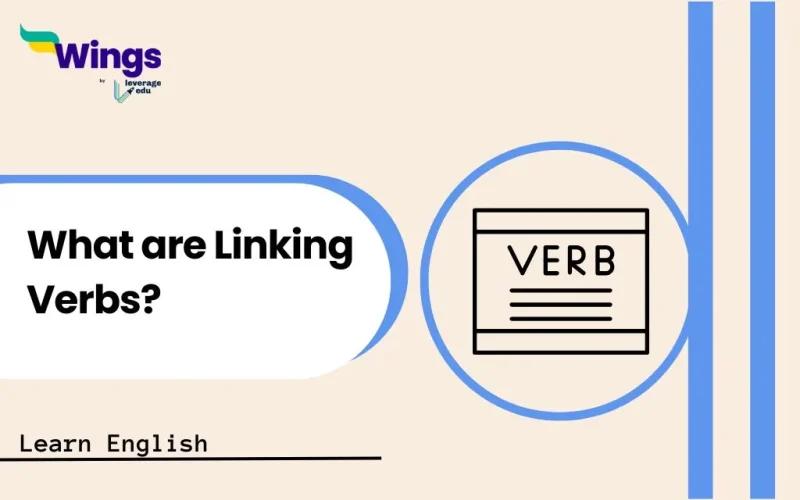What are Linking Verbs: Verbs which connect the subject of a sentence with a subject complement (like a noun, pronoun, or adjective) are known as linking verbs. They do not show action but instead, express a state of being or condition. Common examples include forms of “be” (am, is, are, was, were) and other verbs like “seem,” “become,” and “appear.” These verbs link the subject to more information about its state or identity.
This is another important topic students must understand as they play one of the most crucial parts in English grammar by connecting the subject in a sentence to other parts of speech such as adjectives, and nouns known for describing or identifying the subject.
As you continue reading this blog post, you will find more information about the linking verbs, their functions, types, and rules along with some practice exercises to test your understanding.
This Blog Includes:
What are Linking Verbs?
As we talked earlier, linking verbs describe the subject rather than the action that is taking place in the sentence. For a clear understanding, a linking verb is an intransitive verb that links the subject with a subject complement. This ‘compliment’ can be an adjective, noun or pronoun which describes or renames the subject.
Example:
- “The cake smells delicious.”
Explanation: In this sentence, the verb ‘smells’ connects the cake to the adjective ‘delicious.’
Some common primary examples of these verbs in the English language are “to be,” which includes forms such as “am,” “is,” “are,” “was,” and “were.” Other common examples include “seem,” “become,” “appear,” “feel,” “look,” “sound,” and “taste.”
Also Read:
How Do Linking Verbs Function in English?
A linking verb can be used for various reasons in the English language, let us look at some of them:
- To link one part of the sentence (subject or object) to another (subject or object).
- Linking the subject with additional information about the subject or complement (adjective/nouns/pronouns) to describe the subject.
Example: “The flowers are beautiful.” (Here, “beautiful” describes “the flowers.”)
- To denote an existing relationship or condition of the subject in a sentence.
*Keep in mind that linking verbs are not meant to denote an action but just act as a link. They are normally found right next to the subject in a sentence.
How are Linking Verbs Used in Sentences?
Before we begin with understanding how linking verbs are used in sentences, one must remember that these verbs always follow subject-verb agreement (i.e. a word or a phrase which identifies or describes the subject) and are conjugated for tense. The two main types of subject complements are Predicative nominatives and Predicate adjectives.
- Predicate nominatives (or predicate nouns) identify the subject using a noun or noun phrase.
- Predicate adjectives describe the subject using an adjective or adjectival phrase.
Also Read:
Types of Linking Verbs
Many might not be aware that linking verbs can also be categorised into two main types:
- Always Linking Verbs: These verbs consistently function as a bridge in a sentence regardless of context.
Examples:
- To be: am, is, are, was, were
- To seem
- To become
- Verbs that can be Linking or Action: Some verbs can act as both linking and action verbs depending on how they are used in a sentence.
For instance:
- Feel: In “I feel tired,” it is a linking verb; in “I feel the fabric,” it acts as an action verb.
- Look: In “She looks happy,” it is linking; in “She looks at the painting,” it is action.
Also Read: Verb Cheat Sheet
Rules for Linking Verbs
Linking verbs are essential in English grammar as they connect the subject of a sentence to additional information about that subject. Here are some key rules to keep in mind when using these verbs:
| Rules | Description | Examples |
| 1. Linking verbs do not express action | Linking verbs connect the subject to a complement, rather than showing an action. | “She is a teacher.” (not an action) |
| 2. Always followed by a subject complement | A linking verb must be followed by a predicate adjective or predicate nominative that describes or renames the subject. | “The soup tastes delicious.” |
| 3. Common linking verbs | Familiarize yourself with primary linking verbs such as: am, is, are, was, were, become, seen, appear, feel, look, smell, sound, taste, remain, grow, turn, stay and prove. | “He seems happy.” |
| 4. Subject-verb agreement | Linking verbs must agree with their subjects in number (singular/plural), regardless of the complement’s form. | “The giraffe is the tallest animal.” |
| 5. Avoid using adverbs as complements | Use adjectives instead of adverbs for subject complements; adverbs can describe the linking verb itself. | “She looks beautiful, not beautifully.” |
| 6. Some verbs can act as both linking and action verbs | Context determines whether these verbs function as linking or action verbs. | “She looks great today.” (linking) |
How to Identify Linking Verbs?
Following are the methods which help you identify linking verbs in a sentence easily:
- Substitution Test:
In this, one must replace the verb in the sentence with ‘is’ or ‘are’. If the sentence still makes sense, the original verb is likely a linking verb.
Example: “The soup tastes delicious.” → “The soup is delicious.” (Both sentences convey the same idea.)
- Look for Subject Compliments:
One must remember that linking verbs are always followed by a subject complement, which can be a predicate adjective or a predicate nominative.
Here are examples for both types:
Predicative Adjective: Describes the subject.
Example: “She is happy.” (Here, “happy” describes “she.”)
Predicative Nominative: Renames the subject.
Example: “He is a teacher.” (Here, “teacher” renames “He.”)
- Recognise Common Linking Verbs:
Familiarise yourself with verbs that are always linking verbs, such as:
- To be: am, is, are, was, were
- To become
- To seem
Additionally, some verbs can function as both linking and action verbs depending on context (e.g., look, feel, taste).
- Contextual Clues:
Determine if the verb describes a state of being rather than an action. If it connects the subject to more information without showing an action, it’s likely a linking verb.
Example: “The flowers smell sweet.” (Here, “smell” connects the subject to the adjective “sweet.”)
Also Read: Nominative Case in English Grammar
Distinguishing Linking Verbs from Other Verbs
Here are the differences between these three types of verbs:
| Particulars | Linking Verbs | Action Verbs | Auxiliary Verbs |
| Function | Connects subject to a complement (description or state). | Shows an action performed by the subject. | Assists the main verb in forming tenses, moods, voices, or questions. |
| Examples | am, is, are, was, were, seem, become, appear | run, jump, read, write, talk, play | am, is, are, have, has, had, will, do, does |
| Purpose | Describes the state or condition of the subject. | Describes what the subject is doing. | Helps convey time, aspect, or mood in the sentence. |
| Example Sentence | She is happy. | She runs every morning. | She has been running for hours. |
Also Read: Auxiliary Verb Worksheet for Students
Common Linking Verb Examples
Take a look at the table showcasing common linking verbs along with their meanings and example sentences to illustrate their use:
| Linking Verb | Meaning | Example Sentences |
| Am | Present tense of “to be” | I am excited about the trip. |
| Is | Present tense of “to be” | She is a talented musician. |
| Are | Present tense of “to be” | They are friends. |
| Was | Past tense of “to be” | He was tired after the long day. |
| Were | Past tense of “to be” | We were happy to see you. |
| Become | To change into or develop into | She became a doctor after years of study. |
| Seem | To appear to be | He seems upset about the news. |
| Feel | To perceive through the senses | The fabric feels soft against my skin. |
| Look | To have a certain appearance | You look beautiful today. |
| Sound | To produce a particular noise or impression | The music sounds lovely. |
| Taste | To have a flavour or quality | This dish tastes amazing! |
| Remain | To continue in the same state | She remains calm under pressure. |
| Appear | To come into sight or become visible | He appears happy in the photos. |
Test Your Understanding of Linking Verbs
Here are some exercises on linking verbs with their answers at the end to help you test your understanding of this topic.
Exercise 1: Fill in the Blanks
Instructions: Fill in the blanks with the appropriate linking verb from the list provided.
| Linking Verbs List: is, are, was, were, become, seem, feel, look, taste |
- The soup ______ delicious.
- She ______ very happy today.
- They ______ tired after the long journey.
- He ______ my best friend.
- The flowers ______ beautiful in spring.
- The cake ______ sweet and moist.
- I ______ excited about the concert.
- The weather ______ nice yesterday.
Answers:
- The soup tastes delicious.
- She is very happy today.
- They were tired after the long journey.
- He is my best friend.
- The flowers are beautiful in spring.
- The cake tastes sweet and moist.
- I am excited about the concert.
- The weather was nice yesterday.
Exercise 2: Identify the Verbs
Instructions: Read the following sentences and underline the linking verbs.
- The sky looks grey today.
- She feels nervous before the exam.
- They are excited about their vacation.
- He became a successful author.
- The music sounds amazing.
Answers:
- The sky looks grey today.
- She feels nervous before the exam.
- They are excited about their vacation.
- He became a successful author.
- The music sounds amazing.
Find related blogs on Learn English!
FAQs
These are verbs connecting the subject of a sentence to a word (usually an adjective or noun) that describes or renames the subject. They don’t show action.
Examples:
“is,” “am,” “are,” “was,” “were” (forms of “be”)
“seem,” “appear,” “become,” “feel,” “look,” “sound,” “taste,” “smell”
Action verbs: Describe an action (e.g., “run,” “jump,” “eat”).
Linking verbs: Connect the subject to a description (e.g., “The sky is blue.” – “is” links “sky” to “blue”).
Some verbs can function as both, depending on how they are used in the sentence.
Example: “The soup tastes delicious.” (linking verb) vs. “She tastes the soup.” (action verb)
Try substituting “is” or “are” for the verb. If the sentence still makes sense, it’s likely a linking verb.
Example: “The flowers smell sweet.” (Can be replaced with “The flowers are sweet.”)
We hope this blog was informative and helped you improve your English skills. You can also follow the Learn English page of Leverage Edu for more exciting and informative blogs related to English grammar and the English language.
 One app for all your study abroad needs
One app for all your study abroad needs















 60,000+ students trusted us with their dreams. Take the first step today!
60,000+ students trusted us with their dreams. Take the first step today!

